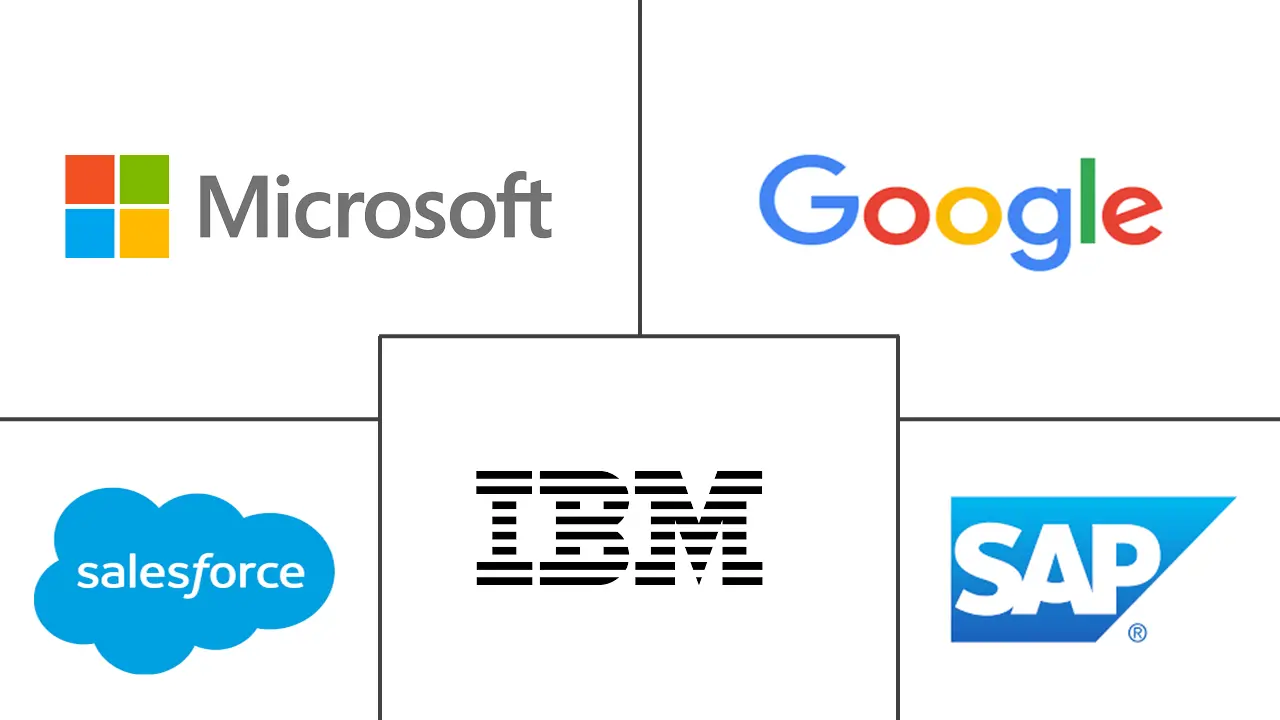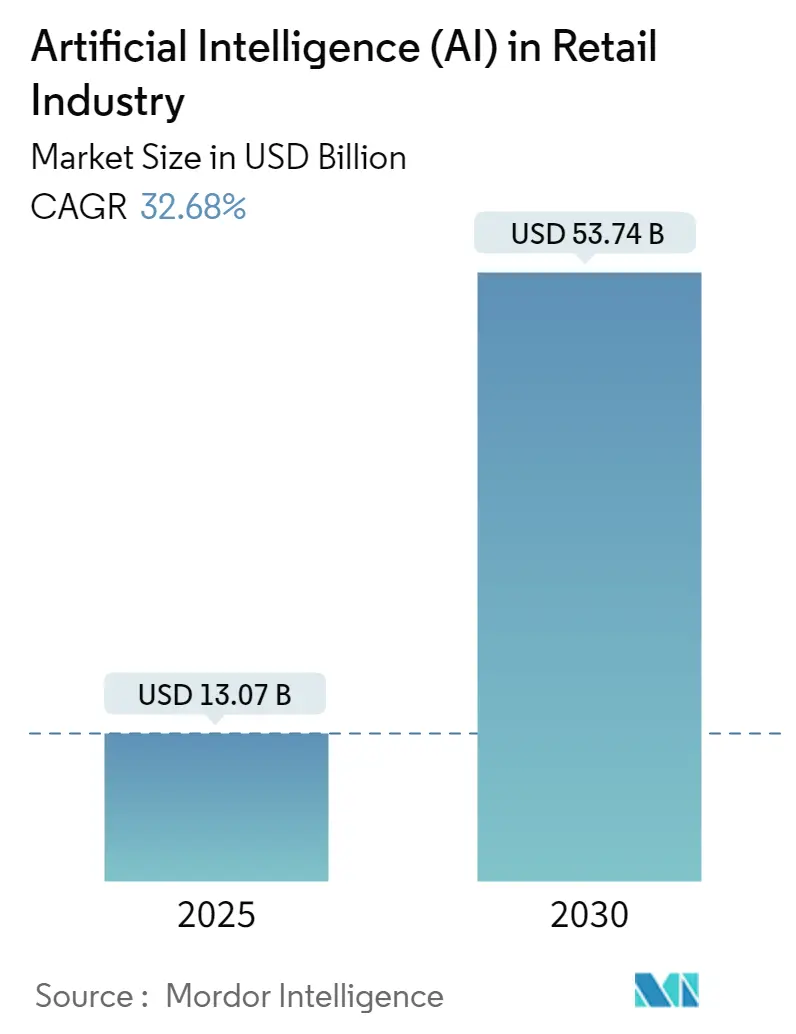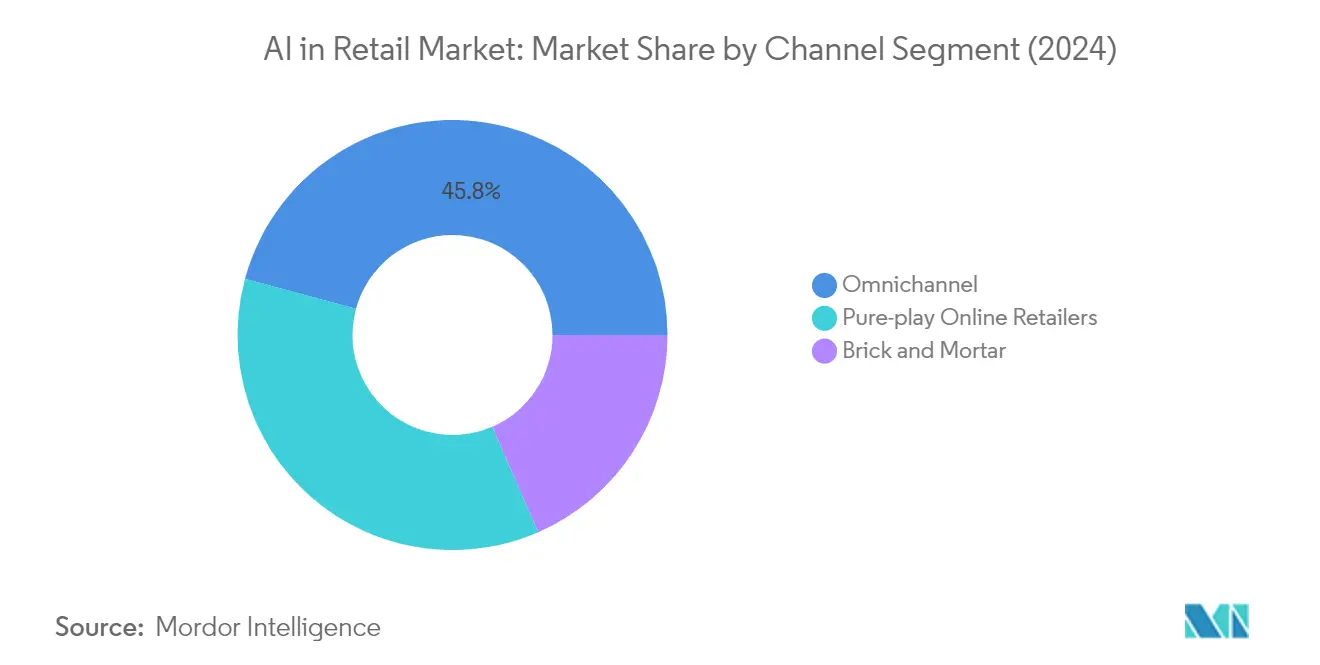Artificial Intelligence (AI) in Retail Industry Size
Artificial Intelligence (AI) in Retail Industry Analysis
The Artificial Intelligence in Retail Industry is expected to grow from USD 13.07 billion in 2025 to USD 53.74 billion by 2030, at a CAGR of 32.68% during the forecast period (2025-2030).
The retail industry is experiencing a fundamental shift toward omnichannel integration, with Harvard Business Review reporting that 73% of customers now utilize multiple channels in their buying journey. This transformation is driving retailers to create seamless experiences across physical and digital touchpoints, supported by sophisticated artificial intelligence in retail algorithms that analyze customer behavior patterns. The integration of IoT devices has further accelerated this transformation, with Cisco predicting approximately 14.7 billion connected devices by 2023. Traditional retail boundaries are dissolving as companies leverage these technologies to create unified shopping experiences that blend online convenience with physical store advantages. These developments are reshaping consumer expectations and forcing retailers to adapt their operational strategies to meet evolving demands.
Despite the digital surge, physical retail maintains its significance, with the Economist Intelligence Unit projecting that brick-and-mortar sales will contribute 85% to retailers' overall revenues in 2024. This resilience has prompted retailers to enhance in-store experiences through artificial intelligence retail solutions. The convergence of physical and digital retail is evident in recent developments, such as Walmart's January 2024 initiative to leverage generative AI in retail for refrigerator restocking and various other in-store operations. This integration of AI technologies in physical stores demonstrates the industry's commitment to enhancing operational efficiency while maintaining the traditional retail experience.
Personalization has emerged as a critical differentiator in retail strategy, with studies indicating that 78% of customers respond positively to personalized offers based on their previous brand engagements. This trend has catalyzed significant technological investments, exemplified by Google Cloud's January 2024 launch of AI tools designed to enhance online shopping experiences through personalized recommendations and interactions. Similarly, Klarna's February 2024 introduction of its AI assistant, which has already engaged in 2.3 million conversations, underscores the growing importance of AI-driven personalization in customer service and engagement.
The retail sector is witnessing a surge in advanced analytics and automation capabilities, particularly in inventory management and supply chain optimization. Microsoft's January 2024 announcement of new generative AI and retail industry solutions for retailers exemplifies this trend, offering capabilities that span the entire retail shopper journey. These solutions enable retailers to unify their data across channels, create personalized shopping experiences, and empower store associates with real-time insights. The integration of visual recognition technology and augmented reality is redefining the online shopping experience, allowing customers to virtually experience products before purchase, thereby reducing return rates and enhancing customer satisfaction.
Artificial Intelligence (AI) in Retail Industry Trends
Rapid Adoption of Advances in Technology Across Retail Chain
Retail chains are rapidly embracing a diverse array of advanced technologies to revolutionize both online and offline shopping experiences. These technologies include AI technology for retailers, augmented reality, cybersecurity solutions, in-store data analytics, voice commerce, and indoor navigation systems. Major retailers are actively implementing these solutions to enhance operational efficiency and customer experience. For instance, in January 2024, Walmart unveiled plans to further harness artificial intelligence in the retail business and drones, introducing AI-powered generative search for iOS customers that tailors product suggestions to match their searches. Similarly, in January 2024, Google Cloud launched a suite of generative AI tools aimed at enhancing online shopping experiences, including an AI-powered chatbot for websites and mobile apps capable of interacting with consumers and offering personalized product recommendations.
The technology adoption trend is further evidenced by significant developments across the retail landscape. In February 2024, Amazon introduced several new generative AI-powered capabilities in its stores to make the shopping experience more convenient, including an AI system that provides customers with comprehensive insights from thousands of reviews. Cloud-based models are enabling retailers to flexibly adjust resource levels based on actual usage, ensuring cost-effectiveness while seamlessly managing high-demand periods. This technological transformation is particularly evident in the Asia-Pacific region, where according to GSMA's Mobile Economy 2023 report, smartphone adoption is expected to reach 94% by 2030, creating a robust foundation for advanced retail AI technology. The integration of these technologies is enabling retailers to process data locally, reduce latency, and ensure real-time analysis and decision-making, crucial factors in today's fast-paced retail environment.
Emerging Trend of Startups in the Retail Space
The global retail sector is witnessing an unprecedented surge in startup activity, driven by increasing disposable incomes, urbanization, digital technology adoption, and growing consumer spending. This trend is particularly notable in emerging economies, where significant capital influx is fueling innovative retail solutions. India, for instance, has emerged as a prime example of this growth, with its retail trading sector attracting USD 4.48 billion in Foreign Direct Investment between April 2000 and June 2023, ranking it fifth globally and contributing approximately 10% to the nation's GDP. Government initiatives like 'Startup India' and supportive policies have created a conducive environment for retail startups, with the Department for Promotion of Industry and Internal Trade (DPIIT) spearheading various projects to nurture the startup ecosystem.
The retail startup landscape is demonstrating remarkable dynamism across different regions, as evidenced by recent market indicators. In Japan, retail sales witnessed a 5.3% year-over-year increase in November 2023, surpassing market expectations and highlighting the sector's growth potential for new entrants. Similarly, Italy's retail trade sales index showed significant improvement, climbing to 107.1 points in March 2023 from 91.8 points in the previous year, with retail sales turnover growing by 1.5% in November 2023. These positive trends are creating numerous opportunities for retail startups to leverage innovative technologies and business models. For instance, in March 2024, Mamaearth, a leading D2C brand in India, expanded its reach by venturing into physical retail, joining the trend of omnichannel retail alongside brands like Licious and Minimalist, demonstrating how startups are successfully bridging the digital and physical retail spaces.
Segment Analysis: By Channel
Omnichannel Segment in AI in Retail Market
The omnichannel segment has emerged as the dominant force in the AI in Retail Commerce market, commanding approximately 46% of the market share in 2024. This leadership position is driven by retailers' increasing focus on delivering seamless integration across various sales channels, including physical stores, websites, mobile apps, and social media platforms. The segment's prominence is further reinforced by retailers' recognition that nearly 73% of customers utilize multiple channels in their buying journey, according to the Harvard Business Review. AI plays a crucial role in enabling companies to gather, analyze, and leverage data from diverse sources, offering unprecedented insights into customer behavior. The effectiveness of this approach is demonstrated by the fact that 78% of customers respond positively to personalized offers based on their previous brand engagements across channels. Major retailers are actively implementing AI-driven omnichannel strategies to enhance customer engagement, optimize inventory management, and create personalized shopping experiences that seamlessly bridge the gap between online and offline channels.
Omnichannel Segment Growth in AI in Retail Market
The omnichannel segment is projected to experience remarkable growth, with an anticipated CAGR of approximately 34% during the forecast period 2024-2029. This exceptional growth trajectory is fueled by the increasing adoption of artificial intelligence solutions that enable retailers to deliver personalized shopping experiences across multiple channels. The segment's growth is supported by ongoing digital transformation initiatives and the rising significance of AI in retail operations. Leading market players are actively rolling out AI-ready solutions to capitalize on this growth opportunity. For instance, in February 2024, Wipro Limited unveiled an AI-ready platform empowering clients to build fully integrated, customized AI environments, offering features like personalized marketing, customer feedback analysis, and support services. This platform specifically caters to the retail sector's growing demand for comprehensive omnichannel solutions, enabling retailers to deliver tailored experiences, strengthen customer engagement, foster loyalty, and drive revenue growth across all customer touchpoints.
Remaining Segments in AI in Retail Market by Channel
The pure-play online retailers and brick-and-mortar segments complete the market landscape, each serving distinct retail strategies and customer preferences. Pure-play online retailers leverage AI technologies to enhance their digital presence, focusing on advanced search capabilities, dynamic pricing optimization, and personalized shopping experiences. Meanwhile, the brick-and-mortar segment is embracing AI to transform traditional retail spaces through data-driven insights, operational efficiency improvements, enhanced customer service, inventory optimization, and customer personalization initiatives. Both segments are witnessing significant technological integration, with retailers implementing AI-powered services to strengthen their market positions and adapt to evolving consumer preferences. The complementary nature of these segments alongside the omnichannel approach creates a comprehensive ecosystem that caters to diverse shopping behaviors and preferences in the modern retail landscape.
Segment Analysis: By Component
Software Segment in AI in Retail Market
The software segment dominates the AI in retail market, commanding approximately 81% of the market share in 2024, equivalent to USD 7.94 billion. This substantial market leadership is driven by retailers' increasing adoption of AI and ML in Retail software solutions to analyze customer behavior and deliver personalized shopping experiences. Leading retail players are leveraging AI software for various applications, including advanced recommendation engines, inventory optimization, and predictive analytics. The segment's dominance is further reinforced by the growing demand for cloud-based AI solutions, which offer scalability and flexibility in deployment. Major technology providers are continuously enhancing their AI software offerings with new capabilities in areas such as generative AI, visual recognition, and natural language processing, enabling retailers to create more sophisticated and personalized customer experiences while optimizing their operations.
Service Segment in AI in Retail Market
The service segment, encompassing both managed and professional services, is projected to exhibit the highest growth rate in the AI in retail market, with an expected CAGR of approximately 38% during the forecast period 2024-2029. This accelerated growth is driven by the increasing complexity of AI implementations and retailers' need for specialized expertise in deploying and managing AI solutions. Professional service providers are playing a crucial role in offering consultancy, customization, and integration services tailored to specific retail business needs. The segment's growth is further fueled by the rising demand for managed services that help retailers navigate challenges related to data security, privacy compliance, and system maintenance. As retailers intensify their AI investments to enhance operations and gain competitive advantages, the demand for both managed and professional services continues to surge, presenting significant opportunities for service providers in the retail AI ecosystem.
Segment Analysis: By Deployment
Cloud Segment in AI in Retail Market
The cloud segment has emerged as the dominant force in the artificial intelligence in retail market, commanding approximately 71% of the market share in 2024. This substantial market leadership is driven by the segment's ability to offer retailers unparalleled scalability and flexibility in their AI operations. Cloud-based AI solutions have gained significant traction as they eliminate the need for expensive hardware infrastructure and maintenance costs associated with on-premises deployments. The pay-as-you-go pricing models have made it particularly attractive for businesses of all sizes, enabling them to access cutting-edge AI capabilities without significant upfront capital expenditures. Furthermore, cloud deployment provides retailers with centralized access to data, enabling seamless collaboration and data sharing across departments and locations. Major cloud service providers like Amazon AWS, Microsoft Azure, and Google Cloud Platform continue to enhance their offerings with specialized resources and services for AI applications in retail, making cloud deployment increasingly attractive for retailers looking to leverage AI technology. The segment is expected to maintain its strong growth trajectory through 2029, with a projected CAGR of around 33%, driven by retailers' increasing preference for flexible, scalable, and cost-effective AI solutions.
On-Premise Segment in AI in Retail Market
The on-premise segment continues to maintain its significance in the AI in retail market, particularly among retailers who prioritize data security and regulatory compliance. This deployment model gives retailers greater control over their sensitive customer data, including personal information and payment details, by hosting AI software on their own servers. The approach is especially crucial for retailers operating in regions with strict data sovereignty requirements, such as Europe and North America, where certain types of data must remain within specific geographical boundaries. On-premise solutions also offer advantages in terms of real-time processing capabilities, allowing retailers to analyze data locally and make instant decisions without potential latency issues. This deployment option particularly appeals to large-scale retailers with established IT infrastructure and those operating in highly regulated environments where data privacy and security concerns are paramount. The segment continues to evolve with new technological advancements, such as hybrid deployment models that combine the benefits of both on-premise and cloud solutions.
Segment Analysis: By Application
Inventory Management Segment in AI in Retail Market
The Inventory Management segment has emerged as the dominant force in the AI in Retail market, commanding approximately 33% of the market share in 2024. This segment's prominence is driven by retailers' increasing focus on optimizing stock levels, reducing costs, and improving operational efficiency through AI-powered solutions. By leveraging artificial intelligence algorithms, retailers can analyze historical sales data, current market trends, and various external factors to forecast demand accurately, helping them maintain optimal inventory levels. Major technology providers are actively developing sophisticated AI-based inventory management tools that enable retailers to automate stock replenishment, predict seasonal demands, and minimize wastage while ensuring product availability. These solutions are particularly valuable for large retail chains managing complex supply networks and diverse product portfolios across multiple locations.
Customer Relationship Management (CRM) Segment in AI in Retail Market
The Customer Relationship Management (CRM) segment is demonstrating remarkable growth potential, projected to expand at approximately 36% CAGR from 2024 to 2029. This exceptional growth trajectory is fueled by retailers' increasing recognition of the importance of personalized customer interactions and data-driven marketing strategies. AI-powered CRM solutions are revolutionizing how retailers engage with their customers by enabling advanced features such as predictive analytics for customer behavior, automated marketing campaign optimization, and real-time personalization of customer interactions. The integration of AI in CRM systems is helping retailers create more targeted marketing campaigns, improve customer service through intelligent chatbots, and enhance customer loyalty programs through sophisticated data analysis and personalization capabilities. Major technology providers are continuously innovating in this space, introducing advanced AI capabilities that enable retailers to better understand and respond to customer needs and preferences.
Remaining Segments in AI in Retail Market by Application
The AI in Retail market encompasses several other crucial segments including Supply Chain and Logistics, Product Optimization, In-Store Navigation, and Payment and Pricing Analytics. Supply Chain and Logistics applications focus on streamlining distribution networks and optimizing delivery routes, while Product Optimization leverages AI to enhance product placement and assortment planning. In-Store Navigation solutions are transforming the physical shopping experience by providing intelligent wayfinding and personalized shopping assistance. Payment and Pricing Analytics applications are revolutionizing how retailers approach pricing strategies and transaction processing, enabling dynamic pricing models and fraud detection capabilities. These segments collectively contribute to the comprehensive digital transformation of retail operations, with each playing a vital role in enhancing different aspects of the retail experience from supply chain efficiency to customer satisfaction.
Segment Analysis: By Technology
Chatbots Segment in AI in Retail Market
Chatbots have emerged as the dominant technology segment in the artificial intelligence in retail market, commanding approximately 37% of the market share in 2024. This significant market position is attributed to the growing dominance of messenger applications and the escalating demand for customer analytics in the retail sector. Retailers are increasingly leveraging chatbot technology to engage with customers in real-time, providing personalized shopping experiences and product recommendations based on customer preferences, including price range, features, and user reviews. These AI-powered chatbots are revolutionizing customer service by offering round-the-clock assistance, handling customer inquiries efficiently, and providing instant responses to common questions, thereby reducing the burden on human customer service representatives while maintaining high levels of customer satisfaction.
Machine Learning Segment in AI in Retail Market
Machine Learning in Retail technology is positioned as the fastest-growing segment in the AI retail market, projected to expand at approximately 35% CAGR from 2024 to 2029. This remarkable growth trajectory is driven by the technology's crucial role in various retail applications, including customer sentiment analysis, dynamic pricing strategies, fraud detection and prevention, demand forecasting, and customer segmentation. Retailers are increasingly adopting machine learning solutions to analyze vast amounts of customer data, enabling them to make data-driven decisions and optimize their operations. The technology's ability to continuously learn and adapt from new data makes it particularly valuable for retailers seeking to stay competitive in an evolving market landscape, while its applications in inventory management and supply chain optimization continue to drive its adoption across the retail sector.
Remaining Segments in AI in Retail Technology Market
The AI in retail market encompasses several other significant technology segments, including Natural Language Processing (NLP), Image and Video Analytics, and Swarm Intelligence, each playing a vital role in transforming retail operations. NLP technology enables retailers to analyze and derive insights from unstructured textual data, enhancing customer service and voice-based shopping experiences. Image and Video Analytics capabilities are revolutionizing visual merchandising, security monitoring, and product recognition systems in retail environments. Meanwhile, Swarm Intelligence, though a relatively newer entrant, is making its mark in optimizing retail operations through decentralized, self-organized systems that enhance decision-making processes in areas such as inventory management and supply chain optimization.
AI In Retail Market Geography Segment Analysis
Artificial Intelligence in Retail Market in North America
North America has emerged as the dominant force in the global artificial intelligence in retail market, commanding approximately 55% of the total market share in 2024. The region's leadership position is primarily driven by the widespread adoption of AI technologies across both online and offline retail businesses to enhance customer engagement and improve sales turnover. Retailers in the United States and Canada are increasingly leveraging AI-powered predictive analytics and machine learning solutions to optimize their supply chains, identify inefficiencies, reduce lead times, and improve overall operational performance. The region's retail sector demonstrates a particular appetite for AI applications in personalized shopping experiences, with retailers analyzing customer data and behavior to offer tailored product recommendations and marketing strategies. The integration of AI in inventory management and optimization has become a cornerstone of retail operations across North America, enabling businesses to maintain optimal stock levels while minimizing costs. Furthermore, the region's robust technological infrastructure and high digital adoption rates have created an environment conducive to AI implementation in retail operations.
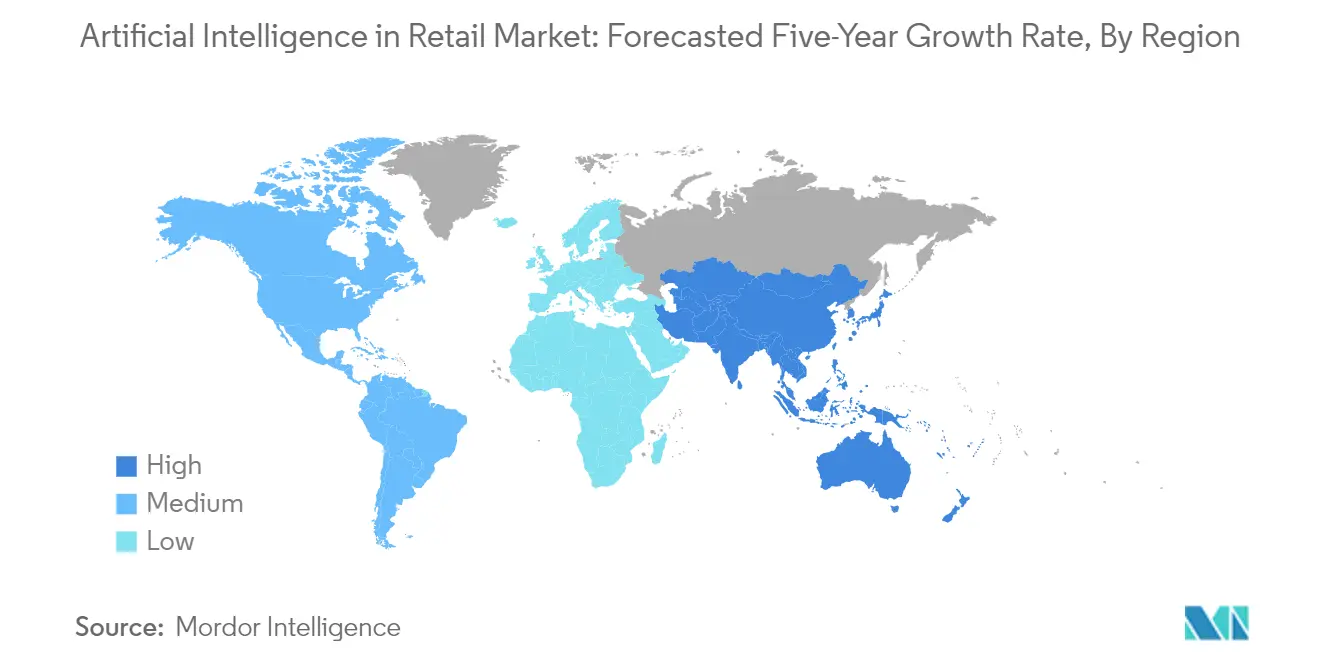
Artificial Intelligence in Retail Market in Europe
The European artificial intelligence in retail market has demonstrated remarkable resilience and growth from 2019 to 2024, driven by the region's increasing focus on integrating AI technologies into various aspects of retail operations. The market has witnessed significant transformation in how retailers operate and interact with consumers, from personalized recommendations to inventory management and customer service optimization. European retailers are particularly focused on enhancing in-store shopping experiences through computer vision and augmented reality technologies, with countries like the UK, Germany, and France leading the adoption curve. The region's strict regulatory framework regarding data sovereignty has shaped unique implementation approaches, with many retailers opting for solutions that ensure compliance with local data protection laws. The market has seen substantial investments in AI-powered chatbots and customer service solutions, reflecting the region's emphasis on enhancing customer engagement while maintaining operational efficiency. Additionally, European retailers are increasingly leveraging AI algorithms to analyze consumer behavior, preferences, and purchase history to deliver highly targeted and relevant product recommendations.
Artificial Intelligence in Retail Market in Asia-Pacific
The Asia-Pacific region is poised for exceptional growth in the artificial intelligence in retail market, with a projected AI market CAGR of approximately 36% during 2024-2029. This robust growth trajectory is underpinned by the region's rapid digitalization and increasing adoption of AI technologies across the retail sector. Countries such as China, South Korea, and Australia are witnessing a remarkable surge in AI adoption as consumers become more digitally savvy and demand personalized experiences. The competitive nature of the Asia-Pacific retail market has driven retailers to embrace AI solutions for providing personalized customer experiences and optimizing operations. The region's retail sector is particularly focused on leveraging AI chatbots and virtual assistants to engage with customers in real-time, providing personalized assistance and support throughout their shopping journey. Furthermore, retailers in the region are increasingly adopting AI-based software solutions to analyze vast amounts of customer data, enabling them to deliver tailored product recommendations, personalized promotions, and targeted marketing campaigns.
Artificial Intelligence in Retail Market in Rest of the World
The Rest of the World region, encompassing the Middle East & Africa and Latin America, is experiencing a transformative shift in retail AI adoption, primarily driven by the increasing penetration of online shopping platforms. These regions are witnessing significant developments in AI implementation across retail operations, with retailers focusing on enhancing online shopping experiences, personalizing recommendations, and optimizing logistics and delivery processes. The retail sector in these regions is particularly embracing AI-based software solutions to revolutionize inventory management and optimize supply chain operations. Retailers are leveraging machine learning algorithms and predictive analytics to optimize inventory levels, reduce stockouts, and minimize overstock situations. The market is characterized by growing investments in AI technologies that enable real-time data analysis, helping retailers forecast demand accurately and streamline supply chain operations. Additionally, these regions are seeing increased adoption of AI solutions for customer engagement and personalized marketing strategies, reflecting the growing sophistication of retail operations.
Artificial Intelligence (AI) in Retail Industry Overview
Top Companies in AI in Retail Market
The retail AI companies market features prominent technology leaders including SAP SE, IBM Corporation, Microsoft Corporation, Google LLC, Salesforce Inc., Oracle Corporation, and Amazon Web Services, alongside specialized players like ViSenze, Bloomreach, SymphonyAI, Daisy Intelligence, and Conversica. These companies are driving innovation through continuous development of advanced artificial intelligence retail solutions, with a particular focus on generative AI capabilities, chatbots, and machine learning algorithms for retail applications. Companies are demonstrating operational agility by rapidly integrating new AI technologies into existing retail platforms and solutions while forming strategic partnerships to enhance their market presence. Major players are expanding their geographical footprint through both organic growth and strategic acquisitions, particularly in emerging markets where AI adoption in retail is accelerating. The market is characterized by substantial investments in research and development, with companies regularly launching new products and features to address evolving retailer needs across omnichannel operations, customer experience enhancement, and supply chain optimization.
Dynamic Market Structure Drives Competitive Evolution
The AI retail industry exhibits a complex competitive structure where global technology conglomerates compete alongside specialized AI solution providers. Large technology companies leverage their extensive resources, established customer relationships, and comprehensive product portfolios to maintain market dominance, while specialized players carve out niches through focused innovation in specific retail applications. The market is experiencing moderate consolidation as larger players acquire innovative startups to expand their technological capabilities and market reach, particularly in areas like visual search, conversational AI, and predictive analytics.
The competitive landscape is further shaped by strategic partnerships between technology providers, retailers, and industry stakeholders, creating an interconnected ecosystem of solutions and services. Market participants are increasingly focusing on developing integrated platforms that combine various AI technologies to provide comprehensive retail solutions. The presence of numerous regional players, particularly in Asia-Pacific markets, adds another layer of competition, with these companies leveraging their local market knowledge and relationships to compete effectively against global players.
Innovation and Adaptability Drive Future Success
Success in the AI retail market increasingly depends on companies' ability to deliver scalable, customizable solutions that address specific retail challenges while maintaining technological leadership. Companies must focus on developing robust data security measures, ensuring regulatory compliance, and building trust with retailers through transparent AI implementations. The ability to provide seamless integration with existing retail systems, demonstrate clear return on investment, and offer comprehensive support services will be crucial for market players to maintain and expand their market share.
For new entrants and smaller players, success will depend on identifying and exploiting underserved market segments, developing specialized solutions for specific retail applications, and building strategic partnerships with established retail technology providers. Companies must also prepare for potential regulatory changes regarding AI implementation and data privacy while maintaining flexibility to adapt their solutions accordingly. The market's future will be shaped by the ability to address growing end-user demands for explainable AI, ethical AI implementations, and solutions that can effectively handle increasing data volumes while delivering actionable insights for retailers. This evolution will further influence the retail intelligence software market as companies strive to integrate AI and machine learning in retail to meet these demands.
Artificial Intelligence (AI) in Retail Industry Leaders
-
SAP SE
-
IBM Corporation
-
Microsoft Corporation
-
Google LLC
-
Salesforce Inc.
- *Disclaimer: Major Players sorted in no particular order
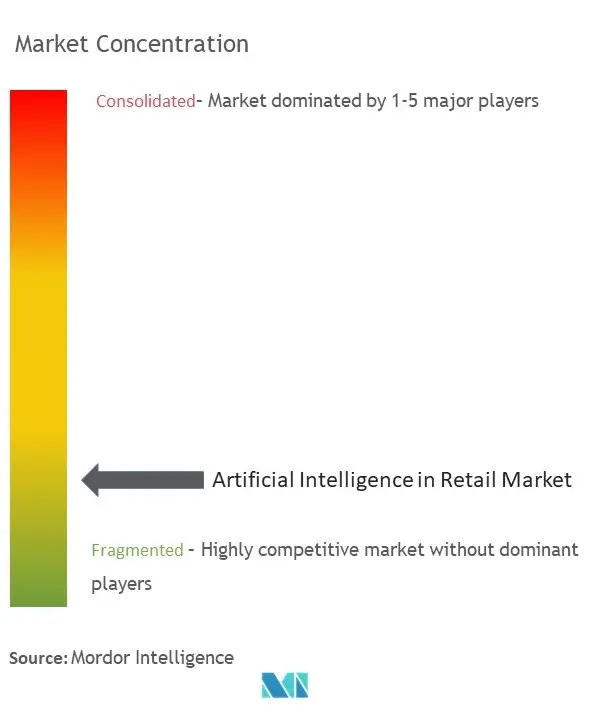
Artificial Intelligence (AI) in Retail Industry News
- January 2024: Through Google's cloud business, it introduced new tools to use generative AI in retail. The tools that retailers will use Google Cloud to improve customer experience on the Internet are based on emerging technology. One of the tools is a generative AI-powered chatbot that can be embedded in retail websites and apps. Google introduced a new large language model, LLM, that it says improves the ability to search for retailers' websites.
- November 2023: Amazon Web Services Inc. announced a new type of generative AI-powered assistant specifically designed for work that could be tailored to the customer's business: Amazon Q. Amazon Q provides information and advice for employees to simplify their tasks, speed up decision-making and problem-solving, which helps ignite creativity and innovation in the workplace.
Artificial Intelligence (AI) in Retail Industry Industry Segmentation
Artificial intelligence is an approach for teaching a computer, a robot operated by a computer, or software to think critically and creatively like a human mind. AI is achieved by examining the cognitive processes and researching the patterns of the human brain. These research projects produce intelligent systems and software.
The artificial intelligence in the retail market is segmented by channel (omnichannel, brick and mortar, and pure-play online retailers), component (software, service [(managed and professional)]), deployment (cloud and on-premise), application (supply chain and logistics, product optimization, in-store navigation, payment and pricing analytics, inventory management, and customer relationship management((CRM))), technology (machine learning, natural language processing, chatbots, image and video analytics, and swarm intelligence) and geography (North America, Europe, Asia-Pacific, and the Rest of World). The report offers the market size in value terms in USD for all the abovementioned segments.
| By Channel | Omnichannel |
| Brick and Mortar | |
| Pure-play Online Retailers | |
| By Component | Software |
| Service (Managed and Professional) | |
| By Deployment | Cloud |
| On-premise | |
| By Application | Supply Chain and Logistics |
| Product Optimization | |
| In-Store Navigation | |
| Payment and Pricing Analytics | |
| Inventory Management | |
| Customer Relationship Management (CRM) | |
| By Technology | Machine Learning |
| Natural Language Processing | |
| Chatbots | |
| Image and Video Analytics | |
| Swarm Intelligence | |
| By Geography*** | North America |
| Europe | |
| Asia | |
| Australia and New Zealand | |
| Latin America | |
| Middle East and Africa |
Artificial Intelligence (AI) in Retail Industry Research FAQs
How big is the AI In Retail Market?
The AI In Retail Market size is expected to reach USD 13.07 billion in 2025 and grow at a CAGR of 32.68% to reach USD 53.74 billion by 2030.
What is the current AI In Retail Market size?
In 2025, the AI In Retail Market size is expected to reach USD 13.07 billion.
Who are the key players in AI In Retail Market?
SAP SE, IBM Corporation, Microsoft Corporation, Google LLC and Salesforce Inc. are the major companies operating in the AI In Retail Market.
Which is the fastest growing region in AI In Retail Market?
North America is estimated to grow at the highest CAGR over the forecast period (2025-2030).
Which region has the biggest share in AI In Retail Market?
In 2025, the North America accounts for the largest market share in AI In Retail Market.
What years does this AI In Retail Market cover, and what was the market size in 2024?
In 2024, the AI In Retail Market size was estimated at USD 8.80 billion. The report covers the AI In Retail Market historical market size for years: 2019, 2020, 2021, 2022, 2023 and 2024. The report also forecasts the AI In Retail Market size for years: 2025, 2026, 2027, 2028, 2029 and 2030.
Our Best Selling Reports
Artificial Intelligence (AI) in Retail Industry Research
Mordor Intelligence provides comprehensive insights into the rapidly evolving AI in retail industry. We leverage our extensive experience in technology market analysis. Our detailed report examines how artificial intelligence in retail is transforming business operations. It focuses particularly on AI applications in retail and emerging retail AI technology. The analysis, available as an easy-to-download report PDF, covers crucial developments in AI and machine learning in retail. It provides stakeholders with actionable intelligence about retail AI companies and their solutions.
The report offers an in-depth analysis of the artificial intelligence retail solutions landscape. It examines the AI market CAGR and growth trajectories across various segments. Our research thoroughly investigates the application of artificial intelligence in retail sector. This includes detailed case studies and implementation strategies. Stakeholders gain valuable insights into AI in retail market size, technological advancements, and future trends. These insights are supported by our extensive retail market intelligence data. The report particularly benefits decision-makers seeking to understand the impact of AI on retail industry. It helps them optimize their technological investments in the retail sector.

